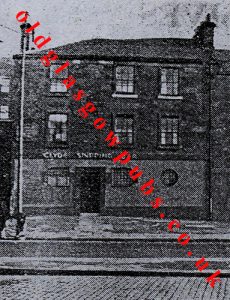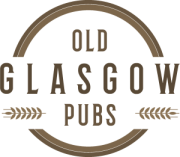85-87 Finnieston Street, Glasgow. G3 8HB. Demolished.

There has been a public house on this site since 1850. The first licensee to acquire a licence for these premises was spirit dealer James Higgins. Mr Higgins continued serving the locals here until 1867.
William Richardson was the next spirit merchant to own this old pub. William lived with his wife and family at 1 Kent Road. By 1875 Mr Richardson also owned a public house in Cranston Street many will remember this old pub as the Prince of Wales Tavern. William continued to hold the licence until 1892.
In 1881 William Richardson was 56 years of age and living at 111 Finnieston Street with his daughter Mary.
The next gentleman to hold the licence was John Bathgate. John was also a restaurateur in Linthouse Hall, Govan. John only lasted a few years here and gave it up in 1895.
In 1895 John Fraser acquired the licence. John paid an annual rent of £90 for the premises. He lived at 30 Derby Street before moving to better accommodation at Comleypark, Dunfermline. Mr John Fraser continued in this pub until 1923.
Alexander S Donald then took over the licence in 1924. Alexander also owned the Clyde Vaults, 150 Gallowgate and a public house at 13 Green Street, Clydebank. Mr Alexander S Donald was the last person to hold the licence and the pub was demolished in the early 1950s.
In the News 1950…
The Clyde Shipping Bar at World’s End.
Iv’e been to the World’s End – not somewhere over the rainbow, but along the dreary congested Street of Glasgow’s Dumbarton Road to the once rural village of Finnieston where now giant cranes and multicoloured ship funnels tower up from the docks like giant ungainly flowers stretching to reach the sun.
It is doubtful if one in a hundred of the dockyard workers who daily stream up the Finnieston Main Street realises that they constantly pass World’s End, or if many of the customers who sip their beer in the Clyde Shipping Bar know that the pub looks into man-made “eternity.”
Pity that the Shipping Bar did not think to perpetuate this old Finnieston name and allow some artist’s imagination full scope to design a sign as unique as the name “World’s End Bar.”
There is certainly no doubt that the Clyde Shipping Bar, in spite of it’s modern front is entitled to associate itself with the oldest memories of Finnieston. It is housed in an old building built one believes in the early 1800s. At one time the building was an inn and between the grocer’s shop at one end and the pub at the other one can just discern the faint printing on the walls, “Finnieston Inn and Tavern.”
Below the grocer’s shop are the old inn cellars and above, where once the Finnieston Inn provided its humble hospitality, are dwelling houses out of one of which the day I passed that way trundled a little old man with a slice of bread for a cart-horse. It is a bitterly cold day and frankly, I was wearing two pullovers, my heavy coat and a scarf. “You’ll catch a cold,” I suggested. He looked at me who I am sure must be over ninety, “Cold!” he exclaimed. “It’s nae cold!” They breed them tough in Finnieston.
The Blind Man’s
At one time the pub was known as the Blind Man’s because, I’m told, the landlord was blind. The present licence-holder is Mr A Donald who has been keeping a merry weather eye on this convivial port for almost 30 years.
Probably the tavern building was built about the time the Townhead weavers in Glasgow gathered up their looms and flocked to the new village laid out by Matthew Orr, of Barrowfield in 1768 and named Finnieston in honour of the Rev. John Finnie who had been tutor to Orr and to Anderson, founder of the Anderston and Finnieston villages.
World’s End, now known as Greenhill Place, down which the port-hole windows of the Clyde Shipping Bar face, was more than an affectionate local name, for it appeared in the Glasgow Post Office Directory in the middle of last century. There are various suggestions as to how the name World’s End came into being. The one generally accepted is regarding the weavers who, it is said, took a very gloomy view of the state of the country and thought it was finished. They said they would go “to the end of the world” rather than live in such a country. They disappeared and then turned up in the little village of Finnieston!
Another Suggestion
An old Finnieston worthy in The Shipping Bar had another suggestion. He pointed out of the port window to the vacant ground at the corner of Greenhill Place. “There he said,” used to be the road there a man McGreath’s farm which stood on the Stobcross estate. A farm were nothing but green fields. I waited for the further explanation and the worthy looked slightly exasperated. “So that was the end of the world,” he added as though unnecessarily.
A third suggested explanation was that the weavers, who were dead religious had waited at some time at the corner, or at least a selection of the population of Finnieston had waited there, for the end of the world. The tenements at the World’s End are old and decrepit and in Greenhill Place only two “closes” remain in their turnpike stairways. Greenhill Street now lacks such grace. Finnieston Main Street is busy and spacious and the fresh breeze from the Clyde blows its cobwebs and litter up to Dumbarton Road. The old village has lost almost all its glamour, but so lang as a few Glaswegians remember how it was once the World’s End a little romance and a little sentimental attraction will always linger round the Clyde Shipping Bar at the end of the world.
Do you remember the old Clyde Shipping Bar or any of the old pubs in Finnieston Street? If so please leave a comment.

Leave a Reply